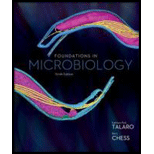
Foundations in Microbiology
9th Edition
ISBN: 9780073522609
Author: Kathleen Park Talaro, Barry Chess Instructor
Publisher: McGraw-Hill Education
expand_more
expand_more
format_list_bulleted
Textbook Question
Chapter 13.L2, Problem 3CT
How could the microbiome cause some infections to be more severe and other infections to be less severe?
Expert Solution & Answer
Want to see the full answer?
Check out a sample textbook solution
Students have asked these similar questions
Explain in a small summary how:
What genetic information can be obtained from a Punnet square? What genetic information cannot be determined from a Punnet square?
Why might a Punnet Square be beneficial to understanding genetics/inheritance?
In a small summary write down:
Not part of a graded assignment, from a past midterm
Chapter 13 Solutions
Foundations in Microbiology
Ch. 13.1 - Describe some of the major interactions between...Ch. 13.1 - Prob. 2ELOCh. 13.1 - Discuss the characteristics of the normal...Ch. 13.1 - Briefly relate the sources and conditions that...Ch. 13.1 - Identify which bodily sites remain free of living...Ch. 13.1 - Prob. 6ELOCh. 13.1 - Prob. 1CYPCh. 13.1 - Prob. 2CYPCh. 13.1 - Prob. 3CYPCh. 13.1 - Prob. 4CYP
Ch. 13.1 - Prob. 5CYPCh. 13.1 - Differentiate between transient and resident...Ch. 13.1 - Explain the factors that cause variations in the...Ch. 13.2 - Review the main stages in the development of an...Ch. 13.2 - Prob. 8ELOCh. 13.2 - Prob. 9ELOCh. 13.2 - Prob. 10ELOCh. 13.2 - Prob. 11ELOCh. 13.2 - Identify and discuss invasive factors and...Ch. 13.2 - Prob. 13ELOCh. 13.2 - Explain several ways in which true pathogens...Ch. 13.2 - Distinguish between pathogenicity and virulence.Ch. 13.2 - Prob. 10CYPCh. 13.2 - Prob. 11CYPCh. 13.2 - Prob. 12CYPCh. 13.2 - Describe several components of pathogens that are...Ch. 13.2 - Prob. 14CYPCh. 13.2 - Prob. 15CYPCh. 13.2 - Define toxigenicity and summarize the main...Ch. 13.2 - Prob. 17CYPCh. 13.3 - Describe the clinical stages of infection.Ch. 13.3 - Use key terms to describe different patterns of...Ch. 13.3 - Prob. 16ELOCh. 13.3 - Prob. 17ELOCh. 13.3 - Explain what is happening during each stage of...Ch. 13.3 - Prob. 19CYPCh. 13.3 - Name some examples of infections and their portals...Ch. 13.3 - 21. Using terminology from this section's “Guide...Ch. 13.4 - Define epidemiology, and summarize the major goals...Ch. 13.4 - Prob. 19ELOCh. 13.4 - Prob. 20ELOCh. 13.4 - Prob. 21ELOCh. 13.4 - Prob. 22ELOCh. 13.4 - Prob. 23ELOCh. 13.4 - Prob. 22CYPCh. 13.4 - Prob. 23CYPCh. 13.4 - Prob. 24CYPCh. 13.4 - Prob. 25CYPCh. 13.4 - Prob. 26CYPCh. 13.4 - What is epidemiologically and medically important...Ch. 13.5 - Prob. 24ELOCh. 13.5 - Prob. 25ELOCh. 13.5 - Summarize the steps in Koch’s postulates, and...Ch. 13.5 - Prob. 27ELOCh. 13.5 - Prob. 28ELOCh. 13.5 - Prob. 28CYPCh. 13.5 - Prob. 29CYPCh. 13.5 - Prob. 30CYPCh. 13.5 - Prob. 31CYPCh. 13.5 - Prob. 32CYPCh. 13.5 - Prob. 33CYPCh. 13.L1 - Prob. 1MCQCh. 13.L1 - Prob. 2MCQCh. 13.L1 - Prob. 3MCQCh. 13.L1 - Prob. 4MCQCh. 13.L1 - Prob. 5MCQCh. 13.L1 - Prob. 6MCQCh. 13.L1 - Prob. 7MCQCh. 13.L1 - The presence of a few bacteria in the blood is...Ch. 13.L1 - Prob. 9MCQCh. 13.L1 - A/an ______ is a passive animal transporter of...Ch. 13.L1 - Prob. 11MCQCh. 13.L1 - Prob. 12MCQCh. 13.L1 - Prob. 13MCQCh. 13.L1 - A positive antibody test for HIV would be a...Ch. 13.L1 - Prob. 15MCQCh. 13.L1 - Prob. 16MCQCh. 13.L1 - Prob. 1CSRCh. 13.L1 - Prob. 2CSRCh. 13.L1 - Prob. 3CSRCh. 13.L1 - Prob. 1WCCh. 13.L1 - Prob. 2WCCh. 13.L1 - Prob. 3WCCh. 13.L1 - Prob. 4WCCh. 13.L1 - Prob. 5WCCh. 13.L1 - Prob. 6WCCh. 13.L1 - Prob. 7WCCh. 13.L1 - a. Outline the five types of clinical isolation....Ch. 13.L2 - Discuss the relationship between the vaginal...Ch. 13.L2 - Prob. 2CTCh. 13.L2 - How could the microbiome cause some infections to...Ch. 13.L2 - Each of the nine patient specimens listed below...Ch. 13.L2 - Prob. 5CTCh. 13.L2 - Prob. 6CTCh. 13.L2 - Prob. 7CTCh. 13.L2 - a. Suggest several reasons why respiratory,...Ch. 13.L2 - Summarize the epidemiological findings in the...Ch. 13.L2 - Looking at figure 13.20b. Which pattern of...Ch. 13.L2 - Prob. 1VCCh. 13.L2 - Observe the following maps (a)-(c) of three...
Knowledge Booster
Learn more about
Need a deep-dive on the concept behind this application? Look no further. Learn more about this topic, biology and related others by exploring similar questions and additional content below.Similar questions
- Noggin mutation: The mouse, one of the phenotypic consequences of Noggin mutationis mispatterning of the spinal cord, in the posterior region of the mouse embryo, suchthat in the hindlimb region the more ventral fates are lost, and the dorsal Pax3 domain isexpanded. (this experiment is not in the lectures).a. Hypothesis for why: What would be your hypothesis for why the ventral fatesare lost and dorsal fates expanded? Include in your answer the words notochord,BMP, SHH and either (or both of) surface ectoderm or lateral plate mesodermarrow_forwardNot part of a graded assignment, from a past midtermarrow_forwardNot part of a graded assignment, from a past midtermarrow_forward
- please helparrow_forwardWhat does the heavy dark line along collecting duct tell us about water reabsorption in this individual at this time? What does the heavy dark line along collecting duct tell us about ADH secretion in this individual at this time?arrow_forwardBiology grade 10 study guidearrow_forward
arrow_back_ios
SEE MORE QUESTIONS
arrow_forward_ios
Recommended textbooks for you
- Case Studies In Health Information ManagementBiologyISBN:9781337676908Author:SCHNERINGPublisher:Cengage
 Concepts of BiologyBiologyISBN:9781938168116Author:Samantha Fowler, Rebecca Roush, James WisePublisher:OpenStax College
Concepts of BiologyBiologyISBN:9781938168116Author:Samantha Fowler, Rebecca Roush, James WisePublisher:OpenStax College


Case Studies In Health Information Management
Biology
ISBN:9781337676908
Author:SCHNERING
Publisher:Cengage


Concepts of Biology
Biology
ISBN:9781938168116
Author:Samantha Fowler, Rebecca Roush, James Wise
Publisher:OpenStax College


Bacterial Infections in Humans; Author: Professor Dave Explains;https://www.youtube.com/watch?v=FeFKAl9KyMg;License: Standard Youtube License